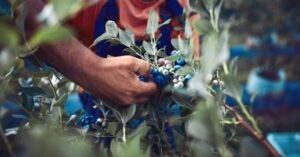Researchers in England have discovered that tiny external structures in the wax coating of blueberries give them their blue coloring, which occurs despite the dark red color of the pigments in the fruit skin itself.
These tiny structures scatter blue and UV light, ultimately giving blueberries their blue appearance to humans and blue-UV to birds. The chromatic blue-UV reflectance arises from the interaction of the randomly arranged crystal structures of the epicuticular wax with light.
The ultra-thin colorant is around two microns thick, and although less reflective, it’s visibly blue and reflects UV well, possibly paving the way for new colorant methods.
The study by a team at the University of Bristol, is titled, Self-assembled, Disordered Structural Colour from Fruit Wax Bloom, and was published today in the peer-reviewed open-access journal Science Advances.
Rox Middleton, Research Fellow at Bristol’s School of Biological Sciences, explained: “The blue of blueberries can’t be ‘extracted’ by squishing — because it isn’t located in the pigmented juice that can be squeezed from the fruit. That was why we knew that there must be something strange about the colour. So we removed the wax and re-crystallised it on card and in doing so we were able to create a brand new blue-UV coating.”

Most plants are coated in a thin layer of wax which has multiple functions, many of them that scientists still don’t understand. It can be very effective as a hydrophobic, self-cleaning coating. However until now, researchers did not know how important the structure was for visible coloration.
Now the team plan to look at easier ways of recreating the coating and applying it. This could lead to a more sustainable, biocompatible and even edible UV and blue-reflective paint.


